Animals Crowding In
Living so close to Westchester, it is only a matter of time until the deer start wandering through the neighborhood. To date, while there is the sporadic sighting Riverdale has been blessedly free of this intrusion. I am particularly grateful since my garden is chock full of hosta which deer seem to regard as a special candy offering.
However, we do share our property with numerous other species. Squirrels are ubiquitous and we see many different birds species regularly. Raccoons are less common now than when we moved here over fifty years ago. We even get the occasional invasion of field mice but all of a sudden there has been an explosion of other animals that I have never seen before.
Baby Boomer Children’s Stories
While we have had the occasional sighting of a rabbit over the last two summers, it was clear this summer that they have taken up residence on our block. Not only did I see adult rabbits but, unsurprisingly given their reputation for multiplying rapidly, having about three litters per year, I have also been seeing young rabbits. Having grown up on the tales of Peter Rabbi by Beatrix Potter and his nemesis, Mr. McGregor, I initially was thrilled to see a little cottontail in my garden. Over time I have learned to have more sympathy for the gardener, Mr. McGregor, and his travails.
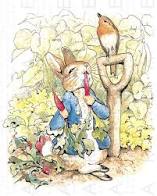

Although Englishwoman Beatrix Potter (1866-1943) was best known for her 23 illustrated children’s tales, she was interested in all the sciences with the exception of astronomy and contributed both illustrations and scientific material on fungi and mushrooms – the science of mycology. Her books grew out of the illustrated stories that she sent to the children of friends over the years using small animals as characters – for example, rabbits, squirrels, mice and cats. In later years she was also an active force in both land conservation and the conservation of older local animal breeds such as Herdwick sheep and Galloway cattle in the Lake District in northwest England.
A Fuzzy Presence
Everyone seems to have a soft spot for rabbits. Trying to be considerate of wildlife that moves in wherever it can, I bought a humane trap and baited it with a carrot. I carefully stationed it in an area where rabbits could be regularly seen hopping through and next morning the trap was full of something furry. But that was no rabbit! Instead it was a huge and very unhappy raccoon. I rebaited the trap a few days later and this time I caught a squirrel. Now I was very unhappy. I baited the trap a few more times but, alas, now no animal was taken in by the offered treat and I still have rabbits romping around my garden.

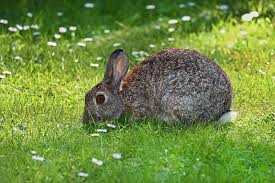
Although once classified as rodents( Order Rodentia), rabbits and hares (which are not the same animals), are now classified as members of the Order Lagomorpha, Family Leporidae. Indeed, there is some evidence that rodents and lagomorphs do share a common ancestor. Hares belong to the genus Lepus while rabbits have numerous genera. My visiting rabbits could be either the New England Cottontail, Sylvilagus transitionalis or the Eastern Cottontail Sylvilagus floridanus.
An older English word for rabbit was coney derived from the Latin cuniculus meaning a rabbit hole. Although there are many contenders for the name of the Brooklyn area named Coney Island, some believe that the island had many rabbits and the Dutch who settled in the area used the Dutch word for rabbits – konijn– which later morphed into coney.

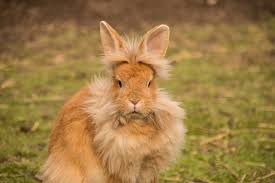
Rabbits but not hares have a long history of domestication. The Romans already were breeding them for meat and fur. The fur of Angora rabbits has even been spun into yarn for luxury materials. And, of course, many people keep rabbits as pets.
Rabbits are altricial, meaning that they are born hairless and blind, thus requiring more maternal care than baby hares which are precocial, born with hair, good vision and mobility. In addition to the characteristic long legs which are an asset for a prey animal, these animals have elongated ears. In addition to their acute hearing, the ears are thermoregulatory structures allowing them to shed excess heat in warm weather and constricting their blood flow in cold weather to prevent excessive heat loss. The rabbit’s ear is shorter than those of the hare.
Ancient Man Encounters Rabbits
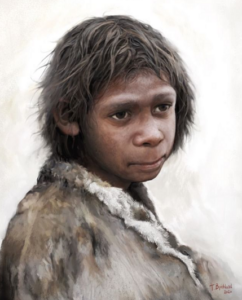
There is an interesting suggestion that change in prey animal availability may have been a factor leading to the demise of the Neanderthal. Large game animals which Neanderthals excelled in hunting became increasingly scarce around 30,000 years ago but there was a concomitant increased presence of the European rabbit – Oryctolagus cuniculus. While anatomically modern humans successfully hunted rabbits as well as larger game, boney remains show little use of rabbits by the Neanderthal leading scientists to conclude that they may have lost the race for survival by gradually running out of adequate nourishing food.
In the meanwhile, I would like my outdoor rabbits to move on before they eat up years of work. Looking online, I discovered a product that uses a granulated form of fox urine. It is meant to be scattered along rabbit trails and frighten them off. I hope it works!

To read more of Sura Jeselsohn’s work, check out her book, A Habit of Seeing: Journeys in Natural Science.
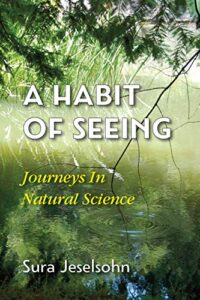
From the little I saw of the book above, I ass.u.me U also include photos, line drawings, maybe footnotes & an index?
The book does have an index and a few pictures. No footnotes or drawings.
Dear Sura,
I so much enjoyed your article. I am impressed with all your research. It was fascinating to me. It reminded me of the years we lived in our home, and I would find racoons in the garbage pail. This is a whole new world to me, and I am so interested.